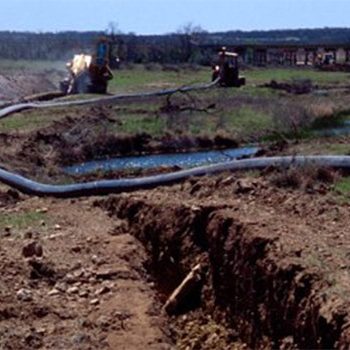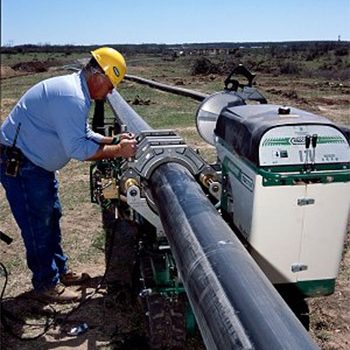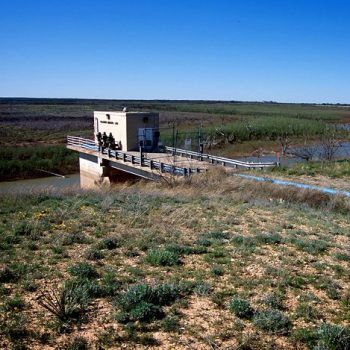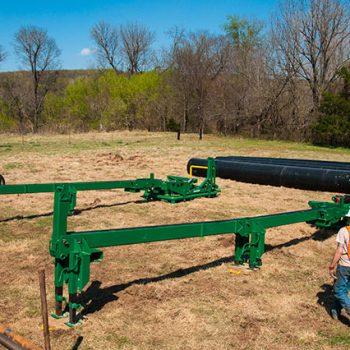Ballinger, TX — Images of polyethylene pipe curving across the West Texas landscape while a massive ditcher carves a slice out of the parched earth might seem like just another construction story. In reality, however, the pipeline is part of a State of Emergency Relief Effort passed by the Governor of Texas to rescue the city of Ballinger from severe drought.
A 14 mile, 10 inch, High Density Polyethylene (HDPE) pipeline is under construction that will bring water from the Abilene-Ivey pipeline (a raw water pipeline that provides water for the city of Abilene) to the Ballinger supply lake, which has slowly dried up over the last seven years. The city, which serves a little over 5,000 people, hopes that this will be a temporary fix until the lake fills back up. If the lake does refill, then the pipeline will only be used as a backup source. The Office of Rural Community Affairs (ORCA) and the Texas Commission on Environmental Quality (TCEQ) are funding the $700,000 project.
If you’re going to ask people to conserve water, it just makes sense for the city to do the same thing and not let it leak from the distribution system.
West Texans have always considered water to be a precious commodity. Texans fiercely defend their water privileges by remaining the only state in the U.S. that guarantees landowners the right to gather as much water as they want from directly below their land. In fact, the entire Panhandle is concerned that this law will make it possible for anyone who owns land in the Panhandle to siphon the Ogallala Aquifer from beneath them and sell it to a metropolitan area in another part of the state.
The severe drought that has gripped the region for the last several years has inspired many city officials to explore a wide variety of conservation methods.
For the city of Ballinger, the solution is High Density Polyethylene pipe (HDPE).”We plan to have the whole town’s water distribution system replaced with polyethylene within the next ten years,” said City Administrator Tommy New. “If you’re going to ask people to conserve water, it just makes sense for the city to do the same thing and not let it leak from the distribution system.”HDPE is the only water piping material that has a 0% leak rating and the city of Ballinger has previously used about three miles of it to rehabilitate a subdivision. In the three years since their first HDPE installation, there have been no reported leaks within the new system.
The city of Ballinger is not alone. According to the EPA, many parts of the country do not have enough water to meet the needs of cities, farms, and the environment, even under normal rainfall conditions. The drought over the last several years has increased competition for limited water supplies and the Interior Department has even developed what they call a “hot spots map.” It is a map that details areas that are potential spots for “water wars” much like the Klamath River basin in Oregon in 2001. That dispute was between farmers and environmentalists over low river levels that endangered salmon populations. It is still in federal court.
According to industry experts, many of the nations water piping systems have reached the end of their life cycle and lose between 15% and 25% of the water they transport through leaks. The Interior Department’s initiative, called “Water 2025” urges conserving water in part by using new technology to replace wasteful systems of water delivery. This thinking is the exact approach that Ballinger is taking.
The 14-mile HDPE water pipeline will replace a five-mile HDPE pipeline that was constructed six months earlier to carry water from the Colorado River to the city lake. A cofferdam was built across the creek channel of the lake to insure the incoming water would stay in the vicinity of the pumping station. Since then, low Colorado River levels have driven mandates that prevent the city of Ballinger from continuing to draw water from the river.
“We told our designing engineer that we would only consider polyethylene for the pipeline,” said New. “It is so easy to work with and tough enough to handle the rough terrain and can be installed into the ditch with a backhoe. If we were using PVC with gasket connections, we would have to have twice the manpower and double the time to build the pipeline because you have to be so careful with it.”
HDPE is heat fused together creating a joint that is stronger than the pipe itself. In effect, there is no joint at all and the pipeline becomes a true monolithic structure.
The pipeline is being fused together with a McElroy TracStar 412 fusion machine. The TracStar is mounted on a rubber track system that enables the machine to shift into position to properly align the pipe ends for fusion. It is also self propelled and can track to different fusion staging areas instead of having to be loaded onto a separate transport vehicle. “This TracStar fusion machine has saved us a lot of money because it has probably cut our fusion time in half,” said New.
Seven directional boars were performed under roads with HDPE that was encased in steel and five ranch owners donated easements to make the pipeline possible. The project also calls for 41 valves, which will be fused onto the pipeline with sidewall fusion. The 14-mile pipeline is on schedule and will be completed in a total of two months.
“Water conservation is nothing new to West Texas,” said Bill Paul, Jr. of Cooper Supply, Inc., the pipe and fusion equipment supplier for the project. Paul has been instrumental in promoting HDPE to the city of Ballinger as well as other municipalities and rural water districts in the region. “In the past, the technology did not exist to build a leak free water system. All of that has changed with polyethylene. It not only saves water, it also saves the city a lot of money over the life of the system.”




